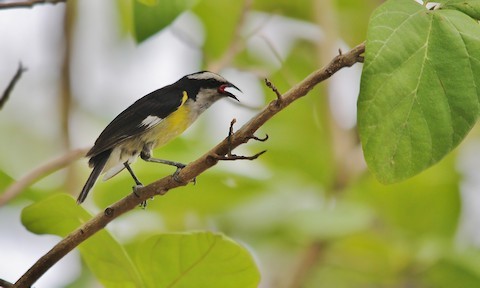Birdfinding.info ⇒ The San Andrés Archipelago’s endemic form of Bananaquit is generally abundant and easy to find throughout its tiny range. Probably the most numerous songbird on Isla Providencia, Santa Catalina, and San Andrés.
“Providencia Bananaquit”
Coereba flaveola tricolor
Endemic to Isla Providencia, Santa Catalina, and San Andrés, where it is widespread and abundant in most habitats.
Identification
Like all Bananaquits, readily recognized by its curved, sharp-tipped bill, broad white eyebrows, dark brown mask and upperparts, and yellow breast—but on “Providencia” the yellow is limited to the mid-breast.
Other distinctive features include a pink gape, yellow rump, yellow shoulders, and a large white spot at the base of the primaries.
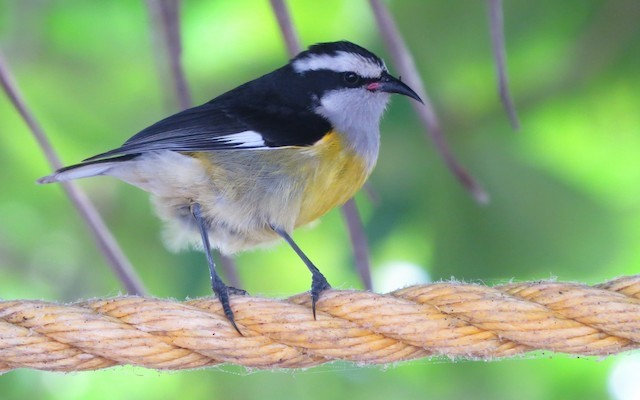
“Providencia Bananaquit”, C. f. tricolor. (Isla Providencia, Colombia; November 28, 2017.) © Rafael Tosi
The “Providencia Bananaquit” (including the San Andrés population) closely resembles the Bananaquit forms that inhabit the Bahamas, Cozumel, and the Cayman Islands. These forms all have a whitish throat that extends down to the upper chest and blends into the yellow of the breast—whereas the “Greater Antillean”, “Lesser Antillean”, and “Continental” forms have a smaller, dark gray throat that contrasts sharply with the vivid yellow chest.
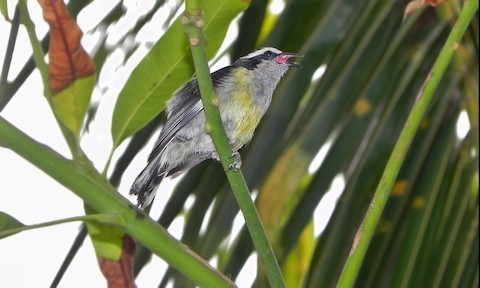
“San Andrés Bananaquit”, C. f. oblita. (Hotel Decameron Aquarium, Isla San Andrés, Colombia; May 26, 2015.) © Adrián Braidotti
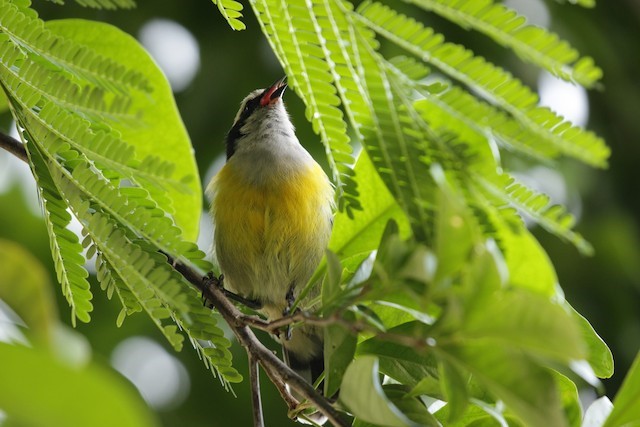
“San Andrés Bananaquit”, C. f. oblita. (Isla San Andrés, Colombia; October 28, 2017.) © Doug Korver

“San Andrés Bananaquit”, C. f. oblita. (San Andrés Botanical Garden, Isla San Andrés, Colombia; April 3, 2019.) © Jose Martinez De Valdenebro
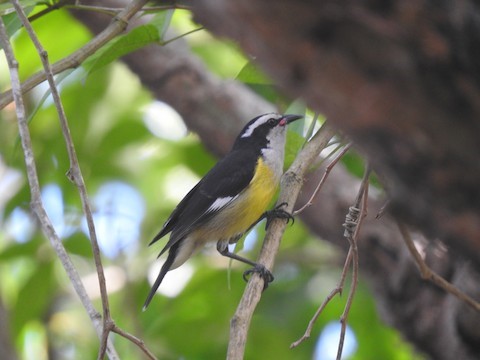
“San Andrés Bananaquit”, C. f. oblita. (Seaflower Biosphere Reserve, Isla San Andrés, Colombia; December 21, 2018.) © Ronald Parra

“Providencia Bananaquit”, C. f. tricolor. (Isla Providencia, Colombia; November 20, 2019.) © xaviervilport

“San Andrés Bananaquit”, C. f. oblita. (Hotel Decameron Aquarium, Isla San Andrés, Colombia; April 25, 2014.) © Jan Cubilla
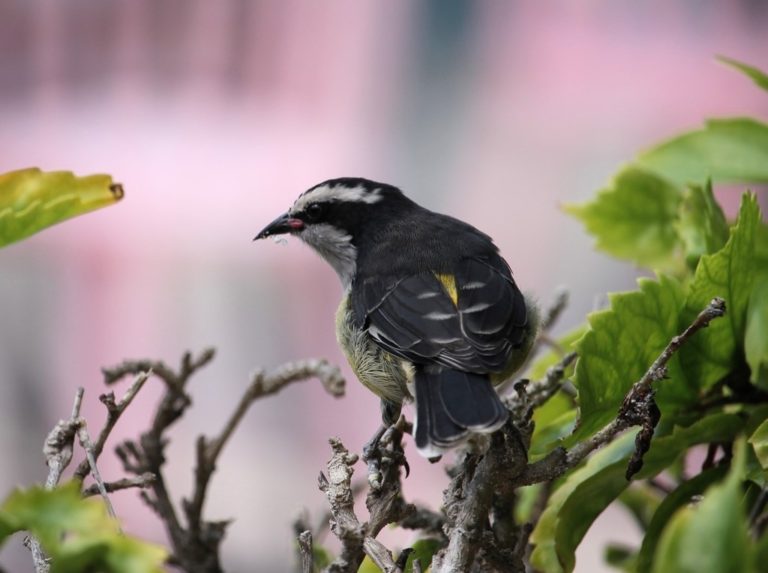
“San Andrés Bananaquit”, C. f. oblita. (Isla San Andrés, Colombia; July 21, 2019.) © Omar Javier López Gómez
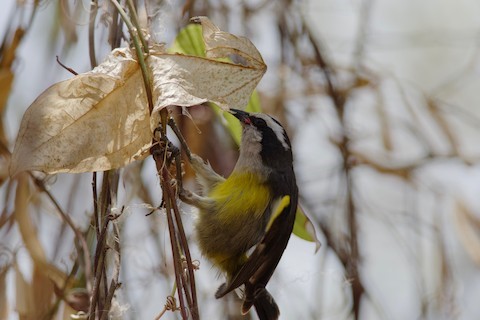
“Providencia Bananaquit”, C. f. tricolor. (Isla Providencia, Colombia; May 7, 2019.) Anonymous eBirder
Immatures are similar to adults but have mostly dirty-yellow underparts and eyebrows.
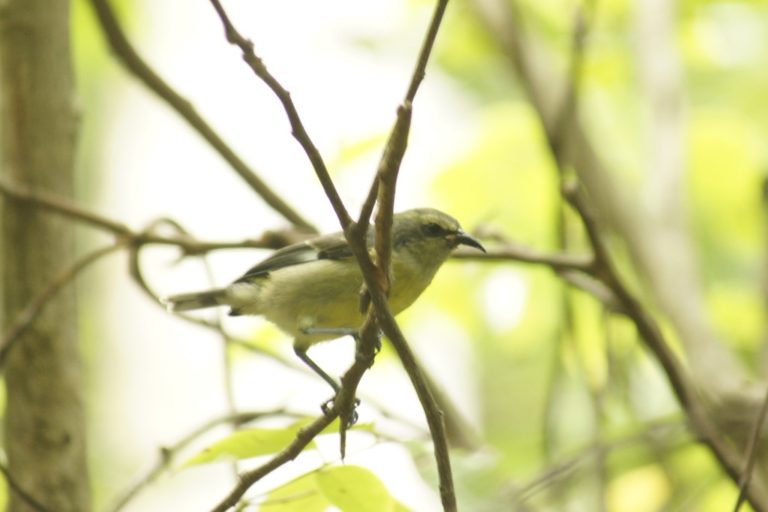
“Providencia Bananaquit”, C. f. tricolor, immature. (Isla Providencia, Colombia; August 6, 2019.) © fotalora

“Providencia Bananaquit”, C. f. tricolor, subadult. (Isla Providencia, Colombia; November 30, 2017.) © Rafael Tosi
Voice: Song is a “sizzling” chatter that builds and subsides:
Providencia birds sing the same sizzling song: Isla Santa Catalina; August 20, 2019. © Sebastián Pérez-Peña.
Typical calls are thin, high-pitched notes:
Notes
Polytypic form consisting of two recognized subspecies: tricolor of Isla Providencia and Santa Catalina and oblita of Isla San Andrés, together comprising one of approximately five to ten potentially distinct forms of Bananaquit. (Note that the two putative subspecies, tricolor and oblita, appear to be visually and vocally indistinguishable from one another, but the name tricolor is older and therefore has priority.) The “Providencia” form is not widely recognized as distinct, but this seems to be an oversight. It appears to be most similar to the “Cayman” form, which itself is peculiarly intermediate between the “Greater Antillean” and “Bahama” forms—according to genetic analysis (Bellemain et al. 2008), “Cayman” is most closely related to “Greater Antillean”, but it visually resembles “Bahama”, and its voice appears to differ from both of them. The “Providencia” form visually resembles “Cayman”, but has a different and more distinctive song: a “sizzling” chatter (the same on both Providencia and San Andrés).
Frontiers of Taxonomy: Bunches of Bananaquits. The 43 or so subspecies of Bananaquit vary significantly in plumage and voice, and it seems clear that what has traditionally been recognized as a single species consists of several distinguishable forms, and likely two or more species, but it is a complex puzzle.
Mitochondrial DNA analysis (Bellemain et al. 2008) indicates that the oldest splits are among three lineages: “Bahama” (bahamensis, plus the “Cozumel” subspecies, caboti); “Greater Antillean” (Jamaican flaveola, Hispaniolan bananivora, “Cayman” sharpei, and possibly also the similar “Providencia” form, which includes tricolor and oblita); and the rest (which can be subdivided into “Lesser Antillean” and “Continental” groups).
References
Bellemain, E., E. Bermingham, and R.E. Ricklefs. 2008. The dynamic evolutionary history of the bananaquit (Coereba flaveola) in the Caribbean revealed by a multigene analysis. Evolutionary Biology 8:240.
Bellemain, E., O.E. Gaggiotti, A. Fahey, E. Bermingham, and R.E. Ricklefs. 2012. Demographic history and genetic diversity in West Indian Coereba flaveola populations. Genetica 140:137-148.
BirdLife International. 2016. Coereba flaveola. The IUCN Red List of Threatened Species 2016: e.T22722080A94747415. https://dx.doi.org/10.2305/IUCN.UK.2016-3.RLTS.T22722080A94747415.en. (Accessed May 4, 2021.)
eBird. 2021. eBird: An online database of bird distribution and abundance. Cornell Lab of Ornithology, Ithaca, N.Y. http://www.ebird.org. (Accessed May 4, 2021.)
Howell, S.N.G., and S. Webb. 1995. A Guide to the Birds of Mexico and Northern Central America. Oxford University Press, Oxford.
Kirwan, G.M., A. Levesque, M. Oberle, and C.J. Sharpe. 2019. Birds of the West Indies. Lynx Edicions, Barcelona.
Seutin, G., N.K. Klein, R.E. Ricklefs, and E. Bermingham. 1994. Historical Biogeography of the Bananaquit (Coereba flaveola) in the Caribbean Region: A Mitochondrial DNA Assessment. Evolution 48:1041-1061.
Xeno-Canto. 2021. Bananaquit – Coereba flaveola. https://www.xeno-canto.org/species/Coereba-flaveola. (Accessed May 4, 2021.)
